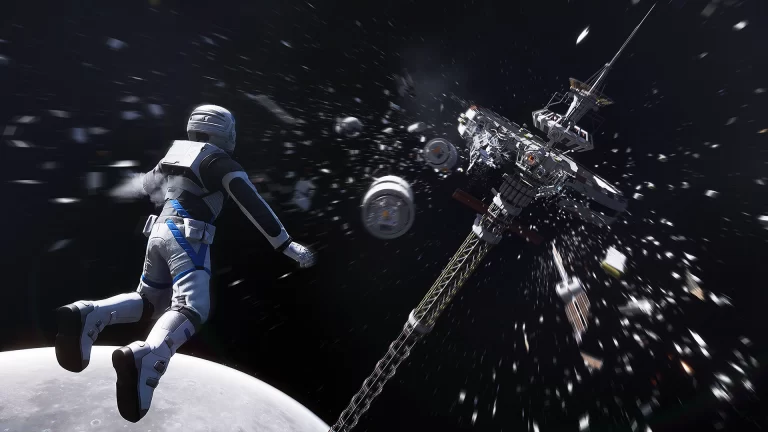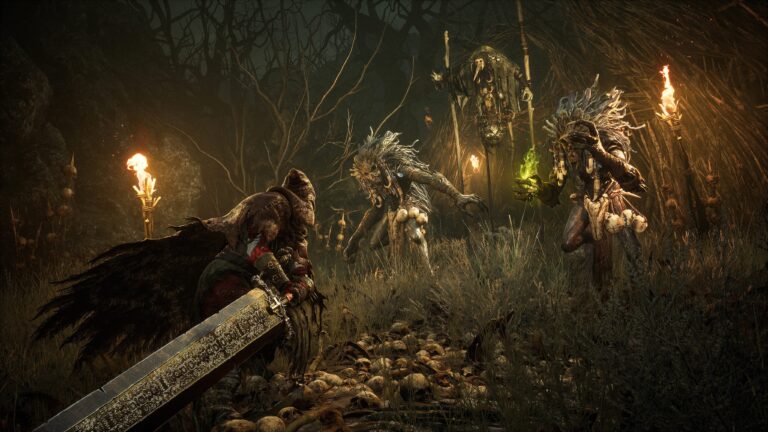Firewatch – Review
Platform – PS4, PC
Developer – Campo Santo
Publisher – Panic
MSRP: $19.99 USD
(Editor’s Note: This game was reviewed on the PlayStation 4 with the game copy being provided by Gaming Instincts.)
Campo Santo has made its initial splash in the gaming world with the first person exploration adventure game Firewatch. It is a linear narrative driven title that sets the player in the wilderness of Wyoming during the late 1980s, taking the role of a volunteer fire lookout over the course of the summer. As banal as this premise may sound, this is a game with many more layers than you might think. Firewatch takes an otherwise boring job and creates a game that challenges the player’s perception of life choices and personal relationships amid a plot of mystery and intrigue. It is perhaps a bit minimalist in terms of gameplay and its technical shortcomings can potentially hinder its immersive qualities. Firewatch travels a path that most other games would not dare follow, but it emerges as an enjoyable and memorable experience in the end.
Story and Pacing
The story of Firewatch put you in the boots of a middle-aged man named Henry who hails from Boulder, CO. Henry’s history is a sad tale of a man who found love, but a cruel trick of took it all away in one fell swoop. The game’s exposition toggles back and forth between first person exploration segments and sections of text offering some choices to flesh out Henry’s back story from the 1970s to the current time respectively. Some of these decisions that you make eventually affect how the game’s core story unfolds, but the tragic elements of his past are set in stone and haunt Henry’s psyche. His wife Julia had developed Alzheimer’s disease at an early age, ruining her career in academia and their marriage in the process.
With his life in shambles and not knowing how to cope with these unfortunate events, he responds to an ad in the newspaper. This is where the game starts proper with Henry making his way to his lookout tower in Wyoming, choosing isolation as a way to deal with his personal woes. It is also the point where you first come into contact with Delilah, Henry’s supervisor at his new job.
Firewatch’s plot spans the course of several days spread across the summer season with Delilah giving Henry new tasks to complete. It is during these days that you get to learn more about the park and Delilah through conversations over a walkie-talkie. As mundane as these exchanges can be, you begin to forge an interesting relationship with Delilah and flesh out Henry’s personality through how you choose to respond to her inquiries.
His new position starts out innocuous enough with having to stop a couple of rowdy teenage girls from illegally lighting off fireworks in the park, but your tasks grow exponentially stranger by the day. This summer eventually changes from a boring gravy job to a desperate struggle to solve a mystery that can possibly put both Henry and Delilah in serious legal trouble. This, in turn, begins to test the mettle of Henry’s relationship with Delilah, whether it be strictly platonic or ambiguously romantic.
The brilliance of Firewatch’s narrative is how watertight the scenario is coupled with the game’s pacing. With Campo Santo clearly knowing what the strengths of this game needed to be, every event that transpires and every seemingly random object or set piece are put where they are for a reason. This even applies to the context sensitive conversations you have with Delilah. You may not realize it at first or even at all depending on how inquisitive or observant you are, but there is a setup and payoff to everything related to unraveling the tale of intrigue that surrounds this park. Not everything is meant to make it easy to solve this mystery, as there are a slew of red herrings that will keep you constantly guessing as to what mischievous activities are happening in this land for whatever reason by a person or persons unknown.
The pacing of Firewatch is the result of a compromise when it comes to gameplay. There is absolutely no combat or advanced agency in traversing the environment to be had therein. Without having to worry about a life bar or engaging in combat, you are free to hike about the land and explore everything it has to offer as long as you have the tools to do so. There is absolutely nothing to get in the way of you satisfying your objectives through these means. There are no time constraints placed on accomplishing these objectives neither.
The overall pace of Firewatch very relaxed as a result and the game can be played through at your leisure. Something that can take away from this pacing is the fact that days in the game will abruptly start with you currently in the middle of a task or will simply end right after making a discovery. Allowing the player to start and end each day leaving the lookout tower and entering sleep would have been preferable. It is important to note this because sometimes it would have been beneficial for the player to hike through the woods to explore more areas or to simply think about what had transpired that day. Otherwise, the pacing of this title is solid and keeps you from losing track of the story.
Gameplay and Controls
The gameplay of Firewatch centers itself around exploration, observation and conversation while you traverse the land. When it comes to the level of interactively afforded to the player, context sensitivity is the name of the game. Even when it comes to navigating the wilderness, there is a limit to what you are allowed to do. Henry can scale certain rock walls and vault over small obstacles when prompted to do so. These formation types are given a similar appearance to aid you in knowing where he can go and where he cannot.
From the outset, you have access to a compass and a map of the grounds. The topographical chart starts out being quite barren. Through accessing new areas and copying notes from other charts stored within caches placed all over the wilderness, you will eventually become more acquainted with the surroundings. Equipped with a walkie-talkie, you can converse with your supervisor Delilah. Henry can also interact with or pick up certain objects, some of which he can add to his inventory. It is curious that you cannot hold on to everything you come across. Some of these items are tools that you can use to access locations blocked by large gaps or rock faces. These items and obstacles can lead to exchanges with Delilah who either helps or jokes with Henry. These mechanics are implemented fairly well and due service to the game’s story progression but some aspects of player agency leave a bit to be desired.
It is fine that there is not any combat oriented action in Firewatch. That is not were a few issues of control come into play, rather it has to do with the agency you do have over Henry. Invisible walls abound to prohibit you from walking through areas of the land that, from a visual perspective, do not look to be inaccessible. While this is a minor annoyance, the bigger headache stems from getting stuck on things like small rocks, some fallen trees and other pieces of organic debris that are littered throughout the park. Some of these obstructions, like the invisible walls, look like they can simply be walked over or jumped. With all of the buttons on the Playstation 4 controller that do not see any use in this game, the sheer lack of a dedicated jump button is absolutely baffling. Despite these hiccups, the provided controls and mechanics are serviceable and work decently enough to fulfill the game’s narrative goals.
Technical Aspects
The accomplishments of this game are definitely worth praise, but it would not be right if its technical aptitude was not addressed. When comes to overall performance, Firewatch stumbles in a few areas. During the first minute of gameplay, it runs at a liquid smooth 60FPS. Upon entering the forest, the frame rate has a tendency to fluctuate. There are times in which the game slows to 30FPS. The issue here is not a lower frame rate, but one that is consistently inconsistent. The autosave feature will even make the game momentarily freeze.
This would not be terrifying on its own if the game has no history of crashing. Unfortunately, during the first play-through for this review, Firewatch crashed twice. The first crash occurred while loading Day 33 and the other happened in-game later on in the session. After completing the game thrice for review, it crashed a total of five times. It is safe to surmise that this title will die on you at least once. The autosave feature will preserve some progress, but not all. With this instability, saving your progress manually is a must.
The shaky performance extends to some of the visuals as well. For reasons unknown, some parts of rock faces will be missing textures, allowing you to literally see through these gaffes. Some of the environmental objects like random trees will spawn clearly above the ground with a painfully noticeable gap of air between the trunk and surface. The game also has some conspicuous pop-in and seems to have trouble maintaining the world in very rare instances. During the first session after getting to Cottonwood Creek, half of the field behind the character’s viewpoint simply disappeared. When turned around to look objects began to blip into existence one at a time after a few seconds. It is unfortunate that these problems exist in Firewatch because they do nothing but marginally diminish its positive qualities.
Length and Replay Value
Firewatch’s overall length depends on how observant and inquisitive one is as a player. This title can be finished in roughly five hours by rushing to complete every objective. Doing this will not yield a satisfying experience. What you get out of Firewatch mostly depends on what you put in. Mining every bit from the game takes roughly fourteen hours.
This is where the replay value comes in. Firewatch tells a very specific story and nothing pertaining to the true plot changes. However, there is are so much information that can be extracted from the game’s world that is not blatantly telegraphed to the player. Chances are you will not pick up on every clue during your first play-through and some clues unequivocally solve the mystery of the Shoshone National Forest.
Graphical and Aural Presentation
From an artistic perspective, Firewatch is a visually stunning depiction of Wyoming’s Shoshone National Forest. This game rides the fine line between being straight out of a postcard and having cartoon aesthetic. The human character models have a caricature look about them and the few animal models are somewhat realistic in shape. The thing can be said for the outdoor environments is that they have the uncanny ability to look like photographs in some instances and have the look of a painting in others. Through the course of Firewatch, you will get the opportunity to see various locations during a different time of the day. There are many moments when the game can be breathtaking like being at Thunder Canyon during sunset, seeing the sun’s heavenly rays of light peek through the clouds and the pastel purples and blues of the sky. Treading through wooded areas, you will see loose leaves drifting in the wind and insects buzzing about open grassy fields. Driving home the notion of isolation, Firewatch does not offer you close contact with other humans. These connections come from other forms of communication through radio contact and contextual clues. This is understandable, but it would have been nice to see more of the wildlife. There is only a handful of occasions in which you come into contact with animals. There could be a case made for the animals vacating the park grounds because of the fire, but their presence could have helped to flesh out the world further in the game before the fire began.
With Firewatch taking place in the first person perspective, there is a lot of detail put into realizing full body consciousness. This is used in almost everything the player does as Henry. With the exception of temporary heads-up display elements that pop up when doing particular actions and an objective reminder, this game basically has no heads-up display. Information pertaining to navigation is obtained through looking at both the actual chart and a compass in Henry’s hands and these models work one-to-one with his current location and direction. It is a great technical touch that complements the other visual elements to create a game world in which you can really lose yourself.
The music and sound design of Firewatch also deserves credit for solidifying what is visually established as well as the theme of isolation. The sound effects are very organic and fit rugged nature of hiking. The distant sounds of wildlife and nearby streams are ambient and dynamic. The soundtrack has a very emotional core and is mostly composed of steady subtle guitar strings and percussion. It is minimalist in its approach in the same way that Erik Satie’s classic Gymnopédies are, but it is incredibly effective. The meandering guitar riffs and steady tempo married with the visuals lure the emotional gravity of the conveyed themes out into the open. When hiking through the forest while the score is playing the game can be a contemplative experience.
However, the crowning achievement in the sound department that ties all of Firewatch’s elements together is the outstanding voice work. Cissy Jones (Delilah) and Rich Sommer (Henry) deserve adulation, as their performances bring these two characters to life in every way. No matter what the tone of any given conversation is, the voice acting is incredibly organic and true to life. You learn so much about both characters just through their vernacular and inflections. The relationship that the player cultivates between Henry and Delilah feels so real as a result and it is such a beautiful thing to witness.
Final Thoughts
Campo Santo managed to take a seemingly monotonous job premise and crafted a solid game around it. As an adventure game, Firewatch succeeds with its setting and a well-written narrative featuring believable characters. The mechanics and gameplay function well enough and are adequate to satisfy the game’s thematic goals. The overall presentation of the game is gorgeous from a visual and aural standpoint, but the performance issues can occasionally take away from its artistry. Despite these imperfections, the team behind this bold and unique game should hold their heads high. Firewatch manages to be a surprisingly enjoyable and emotionally provocative experience that is sure to remain with you long after playing. This is a solid first attempt at a commercial game. If Campo Santo can maintain this level of artistry and improve on the software performance aspect then the future of this indie studio looks very bright.
Firewatch
Pros
- Implements full-body consciousness very well
- Evironments are lush and beautiful
- The dailogue and voice acting are superb and feel organic
Cons
- Suffers from an inconsistent framerate
- Features issues with object placement
- Some environmental elements are missing polygons, looking unfinished
No related posts.











